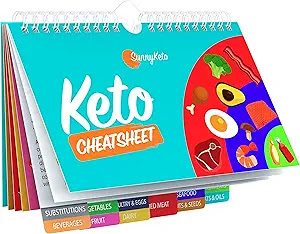The Ultimate Keto Ratio Chart: Your Precision Blueprint for Fat-Burning Success
The Ultimate Keto Ratio Chart: Your Precision Blueprint for Fat-Burning Success
Struggling to crack the code on keto macros? This expert-designed keto ratio chart reveals the ideal fat, protein, and carb breakdown for entering—and staying in—ketosis. Learn how to calculate your perfect ratios for sustainable fat loss, vibrant energy, and peak metabolic performance.
Introduction: Keto Ratios—Your Internal Metabolic GPS
Keto isn’t just another low-carb fad—it’s a calculated biochemical shift. At its core lies one critical truth: macronutrient ratios make or break your results.
Get those numbers wrong, and your body clings to glucose like a safety blanket. But when you dial in the ideal keto macros, you flip the metabolic switch, turning your body into a relentless, fat-fueled engine.
This guide decodes the science of keto ratios—complete with precision charts, expert analysis, and real-life tools. Whether you're just dipping your toes in or fine-tuning your fat-burning edge, consider this your keto command center.
What Are Keto Ratios? (Your Golden Formula for Ketosis)
At the heart of the ketogenic diet is a strategic balance of macros designed to nudge your body into a state of ketosis, where it burns fat for fuel instead of glucose.
Here’s the standard ketogenic macronutrient breakdown:
-
Fat: 70–80% of total daily calories – your primary energy source
-
Protein: 15–25% – enough to support muscle, without spiking insulin
-
Carbs: 5–10% – tightly restricted to trigger and maintain ketosis
Why These Ratios Matter
-
Fat becomes your dominant fuel source—ketones replace glucose.
-
Protein is crucial but must be controlled; excess converts to glucose via gluconeogenesis.
-
Carbs are the strictest limit—exceeding your threshold (typically 20–50g net/day) pulls you out of ketosis fast.
Think of it like a metabolic tightrope—you need balance, not guesswork.
Keto Ratio Chart: Unlock Your Personalized Macros
Here’s your quick-reference keto macro ratio chart, tailored by health goal:
| Your Goal | Fat (%) | Protein (%) | Carbs (%) | Net Carbs (g/day) |
|---|---|---|---|---|
| Standard Ketosis | 70–80% | 15–25% | 5–10% | 20–50g |
| Weight Loss | 75–80% | 15–20% | 5% | 20–30g |
| Muscle Gain | 65–70% | 25–30% | 5–10% | 30–50g |
| Therapeutic Keto | 80–90% | 5–15% | 2–5% | <20g |
Pro Tip: Use a reputable keto macro calculator (e.g., Perfect Keto’s Macro Tool) to customize these percentages to your unique body composition, activity level, and fitness goals.
The Science Behind Keto Ratios: What Your Body Does with Each Macro
1. Fat: The High-Octane Fuel of Ketosis
-
MCTs (e.g., coconut oil): Convert swiftly to ketones for instant energy.
-
Omega-3s (e.g., salmon, flax): Combat inflammation, support heart and brain health.
-
Saturated fats (e.g., ghee, butter): Heat-stable and energy-dense—ideal when balanced with unsaturated fats like olive oil or avocado.
2. Protein: The Repair Crew
-
Too little: Triggers muscle breakdown and fatigue.
-
Too much: Can be converted to glucose, sabotaging ketosis.
-
Optimal range: 0.6–1.0g per pound of lean body mass per day.
3. Carbs: The Gatekeepers of Ketosis
-
Net carbs = Total carbs – Fiber
-
Stick to nutrient-dense, low-glycemic options like:
-
Leafy greens (spinach, kale)
-
Cruciferous veggies (broccoli, cauliflower)
-
Berries (raspberries, blackberries—in moderation)
-
Top Keto Ratio Mistakes (And Smart Fixes)
❌ Mistake #1: “Lazy Keto” (No Tracking, No Progress)
-
The trap: Estimating your meals without tracking leads to hidden carbs.
-
The fix: Use macro-tracking apps like Cronometer, Carb Manager, or MyFitnessPal for accuracy.
❌ Mistake #2: Protein Overload
-
The trap: Overeating protein can convert to glucose, kicking you out of ketosis.
-
The fix: Stick to 4–6 oz per meal and space it evenly throughout the day.
❌ Mistake #3: Fear of Low-Carb Veggies
-
The trap: Skipping vegetables = missing out on essential micronutrients.
-
The fix: Embrace high-fiber, low-carb plants like zucchini, asparagus, cucumber, and arugula.
How to Calculate Your Personalized Keto Macros (Step-by-Step)
Step 1: Estimate Your Daily Caloric Needs
-
Sedentary: Body weight (lbs) × 12
-
Moderately active: Body weight × 14
-
Very active: Body weight × 16+
Step 2: Apply Your Ideal Macro Percentages
Example: 2,000-calorie target on a 75/20/5 keto split
-
Fat: 2,000 × 0.75 = 1,500 cal → ÷ 9 = 167g of fat/day
-
Protein: 2,000 × 0.20 = 400 cal → ÷ 4 = 100g of protein/day
-
Carbs: 2,000 × 0.05 = 100 cal → ÷ 4 = 25g net carbs/day
This is your custom macro blueprint—just plug in your own calorie needs and recalculate.
Keto Ratio Tweaks for Specific Lifestyles
1. Women: Hormonal Shifts and Keto
-
Issue: Hormones can impact keto adaptation and cravings.
-
Solution: Slightly increase carbs (30–40g net) during the luteal phase or PMS.
2. Athletes: Performance Meets Ketosis
-
Issue: Muscle demands can drain glycogen.
-
Solution: Try Targeted Keto—add 20–30g of carbs 30 minutes pre-workout for fuel without breaking ketosis.
3. Metabolic Conditions (e.g., PCOS, Type 2 Diabetes, Epilepsy)
-
Issue: Insulin resistance or neurological needs require stricter ratios.
-
Solution: Adopt Therapeutic Keto (85–90% fat, <20g net carbs)—with medical supervision where appropriate.
Your Keto Ratio Command Cheat Sheet
-
Prioritize healthy fats: Avocados, olives, macadamias, and MCTs
-
Keep protein clean and moderate: Grass-fed meats, wild fish, pasture-raised eggs
-
Restrict carbs smartly: Use fiber-rich veggies to fill the gap
-
Track everything: Apps make it effortless
-
Listen to your body: Biofeedback > rigid rules




Comments
Post a Comment